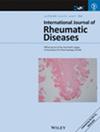Clinical Response to Adalimumab Therapy and Its Determinants in Patients With Radiographic Axial Spondyloarthritis: A Prospective Real-World Study in Taiwan
Abstract
Aim
To investigate the clinical response to adalimumab (ADA) in patients with active radiographic axial spondyloarthritis (r-axSpA) in Taiwan.
Methods
In this real-world study, patients with r-axSpA, starting ADA therapy, were enrolled and followed up every 12 weeks for 48 weeks. Outcome parameters were the proportion of patients with an improvement of 50% in Bath ankylosing spondylitis disease activity index (BASDAI50), inactive disease (ID, < 1.3), and low disease activity (LDA, < 2.1) per ankylosing spondylitis disease activity score–C-reactive protein (ASDAS-CRP) and ASDAS-erythrocyte sedimentation rate (ASDAS-ESR), and change in peripheral and extra-musculoskeletal manifestations. Determinants of BASDAI50 response to ADA were examined. Treatment-emergent adverse events (TEAEs) were recorded.
Results
Of 88 enrolled patients, 86 were analyzed, and 82 completed the study with all patients receiving 40 mg ADA fortnightly. Patients achieving BASDAI50 increased from 79.1% to 80.5% from weeks 12 to 48. At week 48, ASDAS-CRP and -ESR, ID, and LDA were improved from baseline in 60.8%, 74.7%, 42.1%, and 68.4% of patients, respectively. A decrease in enthesitis, peripheral arthritis, dactylitis, and uveitis was noted. Younger age, presence of uveitis, and use of conventional synthetic disease-modifying antirheumatic drugs were the determinants of treatment response. At least one TEAE was reported in 22.7%, serious AEs in 2.3% of patients, and no deaths. The most common TEAEs were upper respiratory tract infection (5.7%) and cough (3.4%).
Conclusions
This real-world, prospective study in Taiwan involving patients with active r-axSpA shows that ADA treatment effectively reduced disease activity and improved physical function. No new safety concerns were noted.

 求助内容:
求助内容: 应助结果提醒方式:
应助结果提醒方式:


